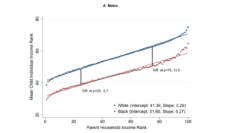Historically Black Colleges and Universities (HBCUs) were founded out of necessity. Prior to the Civil War, education was prohibited for Black people in southern states and thwarted in the north. HBCUs were built, often in the church basements, to educate Black people. Today, they remain a sacred pillar of the Black community.
Attending an HBCU is a different experience for African Americans than attending a predominantly white institution (PWI). Students are relatively sheltered from racial discrimination while attending an HBCU. They are less likely to be the only, or one of few, Black students in the classroom as in most PWIs. HBCU students are also more likely to interact with Black faculty and mentors who have successfully navigated white-dominated environments.
During the critical period of emerging adulthood, HBCU attendance has demonstrated protective mental health effects and is a predictor of socioeconomic achievement for Black people.
Colen, Pinchak and Barnett analyzed data from the Longitudinal Study of Adolescent to Adult Health to investigate the long-term health of African American adults who attended HBCUs compared to those who attend PWIs.
The researchers in this prospective cohort study interviewed middle-and-high school students in 1994-1995. Follow up interviews were conducted in 1996, 2001 and 2008. Black participants who reported attending college during the 2001 follow up were then eligible to provide information for the Integrated Postsecondary Education Data System, where HBCU attendance was assessed.
Colen, Pinchak and Barnett used the 2008 follow-up data to asses five common biomarkers of cardiovascular health. If any three of the five biomarkers (blood pressure, waist circumference, triglycerides, high density lipoprotein or glycated hemoglobin levels) were above the high-risk threshold, the participants were classified as having metabolic syndrome. This condition is a precursor for heart disease and stroke, which both significantly contribute to mortality.
HBCU enrollees had 35% lower odds of developing metabolic syndrome than Black students who attended PWIs.
HBCU enrollees had 35% lower odds of developing metabolic syndrome than Black students who attended PWIs. The investigators controlled for age, biological sex, census region and urbanicity (urban, suburban and rural), the respondents’ baseline health and the early-life social disadvantage of their families, schools, and neighborhoods.
The probability of metabolic syndrome was lower among HBCU students who either attended a predominantly Black high school or lived in a predominately Black neighborhood. HBCU students from predominantly Black high schools (95th percentile) were 12.5 percentage points less likely to develop metabolic syndrome than Black PWI students. Similarly, HBCU students who lived in predominately Black neighborhoods (95th percentile) were 16.4 percentage points less likely to develop metabolic syndrome than their counterparts attending PWIs.
We are only beginning to understand the protective effects of HBCU attendance on physical health for African Americans. The results suggest that the benefits of education are not solely based on what’s learned in the classroom and who shares that room, but on the entire institutional environment.
Photo via Getty Images














